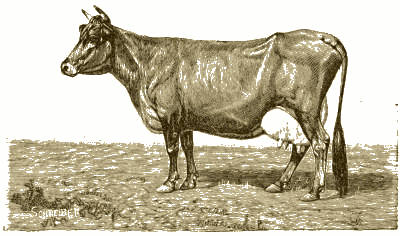
Jersey Cow, Matilda 4th.

Jersey Cow, Matilda 4th.
——A——
Hand-book for the Beginner.
BY
F. S. BURCH,
Editor of the Dairy World.
CHICAGO:
C. S. Burch Publishing Company.
1888.
Entered according to Act of Congress, in the year 1888, by
F. S. BURCH,
In the Office of the Librarian of Congress, at Washington, D. C.
| PAGE | ||
| Milking | 17 | |
| Washing the Udder—The Slow Milker—The Jerky Milker—Best Time to Milk—Kicking Cows—Feeding during the Milking—Loud Talking—Milking Tubes—The Stool—The Pail. | ||
| Care of Milk | 23 | |
| Animal Heat—Milk as an Absorbant—Stable Odors—Cooling—Keeping in Pantry or Cellar—Deep Setting—Temperature of the Water—To Raise Cream Quickly—When to Skim. | ||
| The Milk Room | 27 | |
| To have well Ventilated—Controlling the Temperature—Pure Air—Management of Cream—Stirring the Cream—Proper Temperature at which to keep Cream—Ripening Cream—Straining Cream—Cream in Winter. | ||
| Butter Color | 30 | |
| [Pg x]Rich Orange Color—White butter—The Juice of Carrots—The Use of Annato—Commercial Colors—Beginners generally use too much. | ||
| Churning | 32 | |
| The Patent Lightning Churn—Churning too Quickly—The amount of time to properly do the Work—Churning Cream at 60 degrees—Winter Churning—Starting the Churn at a Slow Movement—The Churn with a Dasher—Stopping at the proper time—Granular Butter—Draining off the Buttermilk—Washing in the Churn—To have the Churn sufficiently Large—Churning whole Milk—The Best Churn for the Dairy. | ||
| Working the Butter | 38 | |
| The Right Temperature—To get the Buttermilk all out—Half Worked Butter—Overworking—Use of the Lever—Working in the Salt—Rule for Salting—Butter Salting Scales. | ||
| Marketing Butter | 43 | |
| The way Four-fifths of the Farmers do it—The Right Way and the Wrong Way—Waiting for Better Prices—City Customers—Have a Commission man Judge your Butter. | ||
| Packing and Shipping | 46 | |
| [Pg xi]The Size and Style of Package—Roll Butter—Packing ter—Packing in Earthen Jars—Tin Packages—The Relative Cost of Wooden Packages—Ninepound Bale Boxes—To avoid "Woody Taste"—Parchment Paper—Excluding the Air—Print Butter—Uniformity of Color—Top of Packages—Keeping Packed Butter Cold. | ||
| Thermometers in the Dairy | 52 | |
| Price of a Good Tested Article—The kind our Grandmothers' used—Floating Thermometers—Importance of their use. | ||
| MAXIMS FOR A B C BUTTER-MAKERS | 54 | |
| How to Make Good Butter. A chapter by Mr. N. Bigalow | 57 | |

| PAGE | |
| Frontispiece. Jersey Cow Matilda 4th. | |
| Milking Tube, | 19 |
| Milk Stool, | 20 |
| Milk Pail, | 21 |
| Haney Deep Setting Can, | 23 |
| Jersey Milk Can, | 24 |
| Shot Gun Deep Setting Can, | 25 |
| Cooley Can, | 25 |
| Conical Skimmer, | 28 |
| Branch of Annato Tree, | 30 |
| Rectangular Churn, | 32 |
| Pendulum Churn, | 33 |
| Bowl of Granular Butter, | 34 |
| Barrel Churn, | 36 |
| Danish Butter Worker, | 38 |
| Eureka Butter Worker, | 39 |
| Favorite Butter Worker, | 41 |
| Butter Salting Scale, | 41 |
| White Ash Butter Tub, | 46 |
| Ninepound Bale Boxes in Crate, | 47 |
| I X L Butter Printer, | 49 |
| Onepound Butter Mould, | 50 |
| Glass Dairy Thermometer, | 52 |
I do not claim anything new or startling for this little work, nor do I claim to be what is usually termed "an authority" on the subject treated. A B C Butter Making is the result of my own experience in the dairy, together with an extended and careful observation of the experiences and practices of some of the most successful butter-makers in the country, and is an answer, in a complete form, to the numberless questions asked me (as Editor of the Dairy World), by beginners in the dairy.
The Author.
Before we can make butter we must have
milk, and a few suggestions on this important
question will not be out of place
here. In order that no dirt or hairs may
find their way into the milk-pail, a careful
dairyman will always brush off the teats and
udder of his cow before he begins to milk,
yet, I am sorry to say, thousands of men who
profess to be careful dairymen do not know
this, and are sometimes guilty of that most
uncleanly habit of softening up the teats by
squeezing out a little milk on their hands. A
large number of cows are utterly ruined every
year by improper milking; irregular milking
spoils a large number; noisy, loud talking
and rough milkers help to spoil a good many
more. The very slow milker, as well as the
quick, jerky milker, who never strips the
cow thoroughly, are helping to make a large
number of our cows unprofitable. Six o'clock
in the morning and six o'clock in the evening
are by far the best hours to do the milking.[Pg 18]
Some of our deep milkers should be milked
three times a day for a week or more after
calving. I might write a chapter on kicking
cows, but after a wide and exceedingly costly
experience in this line will simply say I do
not believe in them, and would not accept the
best one I ever saw as a gift. I am satisfied
that it is not a good plan to feed or "slop" a
cow during the milking, as a hungry animal
will be too deeply absorbed in eating to "give
down" all the milk. Better feed just before
or immediately after milking. Keep strangers
away from the stable during the milking
hour; never carry on a conversation in a loud
voice with some person in another part of the
stable while milking; in short, do nothing
that will be likely to draw the attention of
your cow, or she will in a greater or less
degree "hold up" a part of the milk. When
possible a cow should always be milked by
the same person, as the milker soon learns
any little peculiarity of the animal, and knows
exactly how to handle her, as well as readily
detecting any unusual occurrence, such as
shortage of milk, sore or caked teats, etc.
Milk as rapidly as possible, without jerking,
and avoid hurting the teats with sharp and
long finger nails by keeping them well pared.
Never attempt to draw the milk from a very[Pg 19]
sore or inflamed teat with your hands; it
only causes the animal great pain, and in nine
cases out of ten you will fail to secure all of
the milk. Milking tubes, made of silver, are
not only great conveniences, but now that
they can be bought so cheaply, are an absolute
necessity, and all farmers should keep a few
on hand for use in case of an emergency. The
silver tubes are the best, and can be purchased
for half a dollar each of almost any dealer in
dairy goods. I have mailed thousands of
them during the past few years to dairymen
in all parts of the country, and have received
hundreds of letters stating that valuable
cows have been saved that would otherwise
have been ruined for milking, but for the
use of these tubes. It might be well to say
right here that in no case would I recommend
the use of tubes for regular milking, as their
constant use would soon distend the orifice of
the teat, so that it would leak. Grease or wet
the tubes before inserting, and be careful to
push in slowly. If the teat is very sore the
tubes may be allowed to remain in the teat[Pg 20]
for a day or two, but I would advise that they
be removed after each milking when possible,
and always wiped perfectly dry.

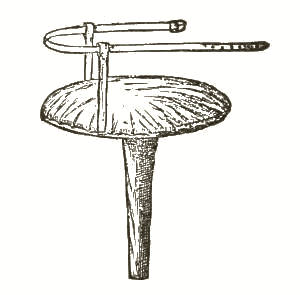
A good milking stool not only adds comfort
to the milker, but helps to facilitate the
work to a greater degree than one would
naturally suppose. I give an illustration of
a handy stool, and as a novice can easily
make one, I will simply say, make the leg according
to the length of your own. Before
closing this chapter on milking I want to say
a word about the pail. Never use a wooden
pail or vessel to milk in. The best pail I
ever used was a patent device called the
"Michigan Milk Bucket," and were it not for
the expense (I believe the price is two dollars),
they would soon come into general use. The[Pg 21]
illustration shows exactly what they are—a
combined pail, strainer and stool; and as the
strainer prevents any dirt or hairs from getting
into the pail, and the close-fitting cover
precludes any possibility of the milk absorbing
stable odors, I cannot say too much in
their praise. When these pails were first
placed on the market the strainer was at the
bottom of the receiving cup, and all the dirt
was washed into the pail, but the manufacturers
altered them by placing the strainer an
inch above the bottom of the receiver, and I
believe that they are now as near perfect a
milk-pail as one could ask for.
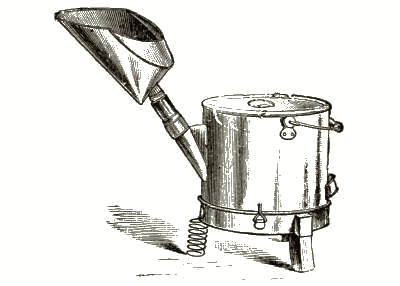
I shall not attempt to enter into the chemistry of the milk. It would be out of place in this A B C treatise. One peculiar thing I wish to draw your attention to is the "animal heat." When the milk first comes from the cow you cannot help noticing that it has a sort of feverish smell, which soon passes off after exposure to the air. This "cowey" smell should, of course, be allowed to pass off, but not in the stable, where the milk would be likely to take on a worse and more lasting odor.
Milk is a great absorbent, and quickly takes
on any and all odors which it comes in contact
with, and when once taken on, they can
never be got rid of. Therefore, the moment
we are through milking a cow, we should
either take the milk out of the stable and into
another room, or pour it at once into a can
or some vessel with a tight-fitting cover, that
it may not absorb stable odors before we are
through with the milking of all the cows. I[Pg 23]
think the best plan is to strain the milk at
once into an ordinary deep setting can and
put the cover on tight. Remove the can, as
soon as it is filled, to the milk-room.
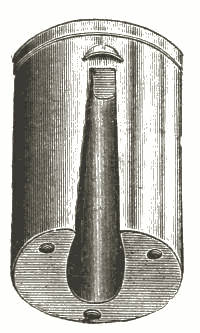
HANEY CAN, BACK VIEW.
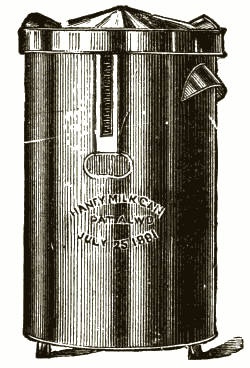
HANEY CAN.
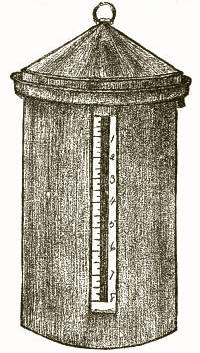
JERSEY CAN.
Now comes the cooling of the milk. To
make good butter we must cool our milk
rapidly. The sooner we cool it down to 47
degrees after it leaves the cow the better the
butter will be. The old-fashioned way of
setting the milk in shallow pans or crocks in
the milk cupboard, which in summer was
placed in the cellar and in the pantry in winter,
is still kept up by a good many farmers, and
this no doubt accounts for the steady production[Pg 24]
of ten-cent store butter with which
our markets are always overstocked. If you
expect to make good butter never set the
milk in the pantry or cellar, as the odors
which it will absorb there are just as numerous,
if not quite so bad, as those in the cow
stable. There is but one way, and dairymen
are pretty generally agreed upon it, and that
is to set the milk in
deep cans in cold
water, and the colder
the water the quicker
the separation of the
cream from the milk.
If you cannot afford
to buy the patent
deep setting cans
like the Cooley, the
Haney, the Jersey,
or the Wilhelm, by
all means get the
common deep setting
"shot-gun"
can, with or without
the glass gauges in
the sides. The purpose of all these cans is to
cool the milk rapidly, and though the manufacturers
of this or that can may claim that
their can does the work more quickly than[Pg 25]
the others, I am of opinion that they are all
good, and one as good as the rest. If you
have a spring, and can set the cans in the
ground, where the water can flow all around
and over the cans, you will be fortunate indeed.
If you have no spring, and cannot
afford a creamer, make a tank a little deeper
than the cans, and keep the water flowing
around the cans. The colder the water the
better. If the water from your well is not
colder than 47 degrees you should use ice.[Pg 26]
By using ice or very cold spring or well water
you get all, or nearly all, the cream to rise in
from twelve to twenty hours, and as I said
before, and I want to firmly impress it upon
your minds, the quicker you get the cream to
rise the better butter you can make. Never
allow the milk to set more than thirty hours,
as it becomes acid or too thick, and loses
much in flavor. I would much prefer to skim
sooner, if I lost some of the cream by so
doing, as I would more than make up what
I lost in quantity by the improved quality.
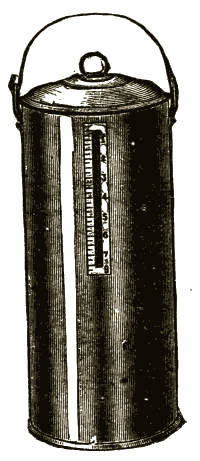
"SHOT-GUN" CAN.
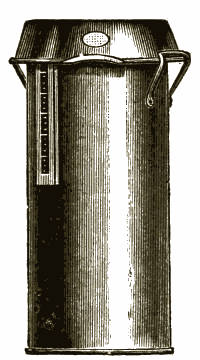
COOLEY CAN.

It would be well to say a word about the milk-room before passing on to the management of cream. It is absolutely necessary that we have a good milk-room in which to not only set the milk, but to ripen the cream, do the churning, and work the butter.
Have the milk-room well ventilated, and build it so that you can control the temperature at the proper point all the year 'round. A good airy place, with plenty of elbow-room is essential. I see too many small, "stuffy" crowded rooms, where there is scarcely a place for half the utensils. Now, see that the air in your room is always pure, and do not pollute it by going directly into it from the cow stable, with all the odors clinging to your clothes and manure on your boots. Also have the room situated as far from the barnyard and hog-pen as possible.
MANAGEMENT OF CREAM.
Skim the milk before the cream becomes
too thick and tough on top. I never allow[Pg 28]
the cream to remain on the milk a moment
after I think it is all up or separated from
the milk. If you use the deep setting cans
you will find the little conical skimmer, with
ten or twelve inch handle, the easiest to skim
with.
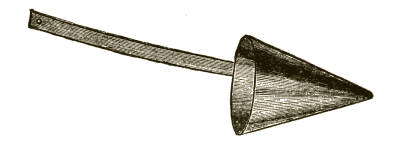
If you put the cream in a can, or other vessel containing cream that was skimmed some hours previous, be sure to stir it all well together, so that it may be of the same consistency. Keep the cream at a temperature of 62 to 68 degrees until it becomes slightly sour, when it is ready for churning. I have churned very sweet cream and very sour cream, but have never been able to get butter of good flavor from anything but slightly soured cream. I am also of the opinion that butter made from cream only slightly sour will keep much longer than when made from a very sweet or sour cream. I am often asked if I think that straining the cream is an advantage, and I will answer by saying that I do think it aids somewhat in helping the[Pg 29] butter to come more evenly. In the winter it may be found necessary to place the cream near the stove, where it can be gradually warmed up to 68 or even 70 degrees, in order to have it sufficiently sour.

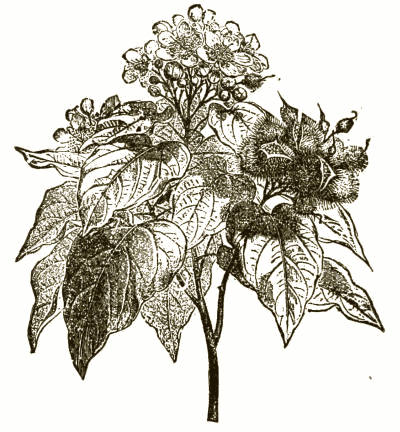
BRANCH OF ANNATO TREE, SHOWING BLOSSOMS AND SEED PODS.
We all prefer to have our butter of a rich
orange color. White butter looks too
much like lard. Then, too, butter of a pale
white hue never sells for as much in the market
as the rich colored article. Years ago
people colored butter with the juice of carrots;
later on the seeds of the Annato plant were[Pg 31]
crushed and the juice mixed with potash and
water. We now have many specially prepared
compounds in the market, put up in
liquid form and ready for immediate use.
Almost all of these commercial colors are
good, but should be used sparingly. Nearly
all the beginners use too much the first time.
There is no general rule to follow in using
color, and you will only be able to tell how
much to use by practice, as the butter of some
cows is naturally of a richer color than others;
this is especially true of the Jersey cows, the
butter from which needs but little artificial
coloring. Always put the coloring into the
cream before beginning to churn.
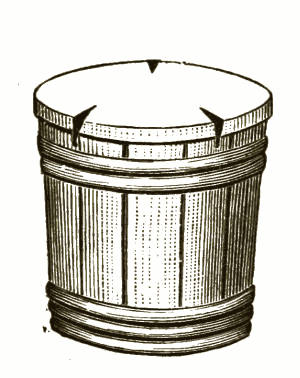
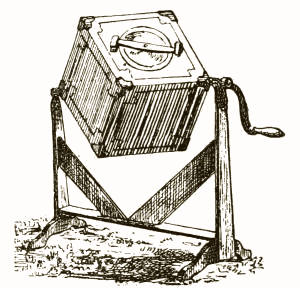
RECTANGULAR CHURN.

PENDULUM CHURN.
Few persons know how to churn properly.
No matter how rich or nice the cream, if
the churning is not done at a proper temperature
and in a proper manner you cannot
make good butter. Avoid the "lightning"
patent churn, which the agent will claim to
bring butter in five minutes. Cream that
is churned too quickly always makes butter
of a cheesey flavor, and quick to get rancid.[Pg 33]
Churning should never be done in less than
twenty minutes, and, if possible, not longer
than forty minutes. Generally the proper
temperature at which to have the cream before
beginning to churn is 60 degrees, but
sometimes this must be varied a few degrees,
according to circumstances. In winter we find
65 or 68 degrees will be necessary in order to
have the butter come within forty minutes.
When cows are fresh the butter comes much
more quickly than it will after they have been
fresh for a long period. Always start the
churn with a slow movement, gradually increasing
until you have reached the proper
speed, which is 40 to 50 strokes per minute.[Pg 34]
I do not believe in the churn with a dash inside,
nor do I believe in keeping the churn in
motion a moment after the cream breaks.
All sensible dairymen are trying to keep pace
with the times, and have adopted the granular
plan. This idea of scooping out great lumps
of butter from a churn, and trying to squeeze
and rub out the buttermilk with its caseous
and albuminous matters is a thing of the
past. Squeeze and press and knead all you
please, and nothing but the water of the buttermilk
will come out; the very impurities
which you desire to get out of the butter will
be all the more firmly incorporated in it. Not
one butter-maker in ten (no, nor fifty) knows
enough to stop the churn at the proper time,[Pg 35]
when the butter has formed into little pellets
the size of a wheat kernel. When those little
pellets have formed, pull out the plug or stopper
in the bottom of your churn; if you have
not got such a thing as a hole in your churn,
don't waste a moment until you have bored
one there, at least an inch in diameter, and
place a small piece of very fine wire sieve on
the inside of the churn over the hole, and
thereafter be careful not to have your plug
so long that it will punch the sieve off every
time you put it in. Let the buttermilk
drain off through this hole, after first pouring
in a little cold water and cooling the contents
of churn down to a point where the globules
or kernels of butter will stick together when
you agitate the churn. Now let the churn
stand and rest a few minutes, then pour in
more cold water, and let it drain off through
the hole again, and if the water comes out as
clear as it went in, stop pouring, shake the
churn a little, then make a good strong brine
of well powdered salt that has been first sifted
thoroughly, cork up the hole and pour in
your brine, and let it stand on the butter for
fifteen or twenty minutes, after which draw
off as you did the water. You now have your
butter in the best possible condition for working.
When you purchase your churn be sure[Pg 36]
and get one large enough; it is much better
to have it too large than not large enough.
If you think you have not sufficient cream
for a churning and the cream is ripe, do not
wait for another skimming, but add sufficient
milk to have the churn filled to about one-fourth
its capacity. Do not use milk that is
very sour, as it is likely to contain so much
casein that your butter will not be of good
flavor. Many dairymen churn all the milk
with the cream, but as it only adds more
work to the churning, I do not recommend[Pg 37]
it except in cases where there is not cream
enough to properly fill the churn. Illustrations
are given of the best churns for the
dairy, viz., the Barrel Churn, the Rectangular
Churn, and the Pendulum Churn.

BOWL OF GRANULAR BUTTER.
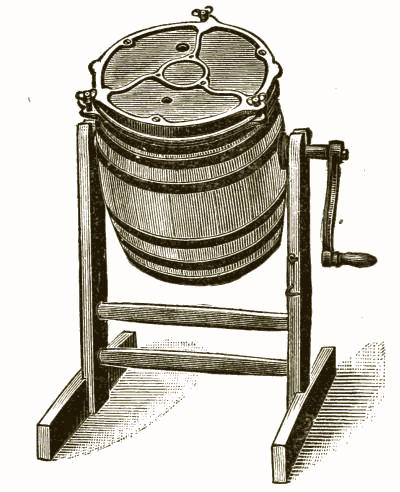
BARREL CHURN.


HOME-MADE DANISH BUTTER WORKER.
Never work the butter when it is too warm. I find that 56 degrees is about right. The main point in working butter is to get the buttermilk all out, and also to get it in good solid compact form. More depends upon proper working than one would naturally suppose. You often see butter with great drops of buttermilk standing all over it; such butter was only half worked, and will generally contain thirty to forty per cent. of water[Pg 39], and will keep sweet but a very short time. The other extreme is overworking, and this produces a dry crumbly mass, with no flavor. If the churning is done as described in the foregoing chapter very little working is necessary, as the buttermilk is very nearly all out of the butter before it leaves the churn. Take the butter out of the churn with your butter spade, and heap it up[Pg 40] on the worker. If too warm for working at once, throw a cloth wet in cold water over it, and leave to drain and cool for thirty minutes. Before using the lever of your worker always dip it in cold water. Now take the lever and gently press the butter out over the full surface of the worker, and sprinkle on some salt; begin at the sides, and roll the butter back into the centre, being careful not to do any rubbing or you will have greasy butter. Now press out the whole mass again, and give it another salting, and repeat the working two or three times until you have incorporated the salt throughout the whole mass evenly. The general rule for salting is to use one ounce of salt to a pound of butter, but as some people like "salty" butter and some "fresh" butter, you must salt according to the wants of your patrons. I always use a fine sieve, and sift the salt over the butter on[Pg 41] the worker, just as the baker sifts his flour over the dough when making it. Much depends upon the quality of the salt used in butter-making, and if you desire to make good butter use only good salt, which is put up in sacks, and branded "Dairy Salt," by nearly all the large salt makers in the country. If you have a large dairy do not trust to guesswork, but buy a scale and use it. An illustration of a scale which is made especially for salting butter is given above. These scales[Pg 42] weigh from one-half ounce up to 250 pounds, and as they can be used for ordinary weighing without regard to the butter-salting attachment, every dairyman should have one. They cost about six dollars.
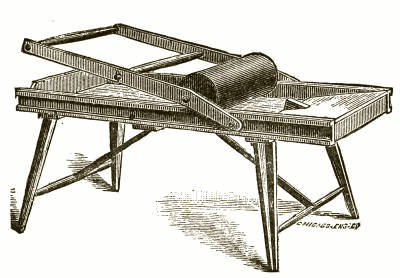
EUREKA BUTTER WORKER.
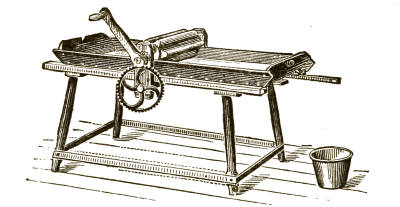
WATERS' PATENT BUTTER WORKER.
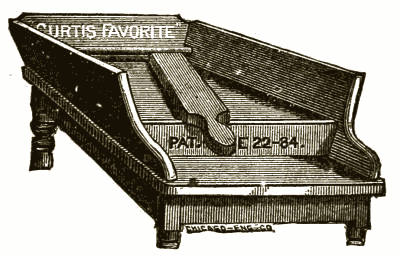
CURTIS FAVORITE BUTTER WORKER, FOR ONE OR TWO COWS.
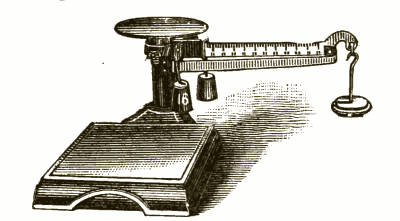
BUTTER-SALTING SCALE.
An illustration of a home-made butter worker, which is used largely by the Danes, is herewith given. Any man that is handy with tools, can make one. Cuts of three other good workers are shown; they are well made, and cost but a small amount.
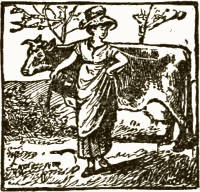
"Butter well made is half sold," says an old maxim; but one would naturally suppose that it was "quite sold," to observe the careless manner in which four-fifths of the farmers market their butter. Who has not observed the tactics of the country storekeeper in buying butter? Here comes Mrs. Smith, or Jones, who is known near and far as a good butter maker. See how anxious the merchant is to please her; he knows that her butter is in great demand and will be sold at a good price before night. He pays her the highest market price, and while weighing the neat prints of golden butter, carefully wrapped in spotless cloth or snow-white parchment paper, tells her that he wishes she could have brought in more. It's a pleasure to have the trade of such a woman. But now comes Mrs. Easy. Observe the cloudy expression on the merchant's countenance, as he tells her that he's overstocked with butter; that the market is "way down." You will notice that he charges her a "long[Pg 44] price" for whatever he sells her, and dumps her butter, which is generally in mussy rolls, into the nearest shoe box. And who can blame him, knowing that he cannot sell Mrs. Easy's butter at home, but must ship it to the nearest market and sell it for "low grade dairy" at a price which seldom, if ever, nets him a profit.
One seldom hears of the markets being overstocked with "gilt edge" butter; on the other hand, the market is nearly always loaded down with "low grades" and grease.
The best plan for marketing butter is to endeavor to find customers at home, and sell as soon as possible. People that pack their butter and wait for a rise, are sometimes disappointed, and no butter can be as good four or six months after it is made as when fresh. It is far better, as a rule, to sell as soon as possible, at the best price you can get, than to wait for a rise that sometimes fails to come.
I receive many letters during the year from people asking me to find them city customers. Such customers, as a rule, are very exacting; they expect much, and paying a high price, have a perfect right to do so. These private customers (unless acquainted with the butter maker) seldom prove agreeable people to deal with. It is better to sell for a few cents less[Pg 45] at home, and leave no chance for dissatisfaction, or if you cannot possibly sell all you make at home, better ship it to some reliable commission merchant, and leave him to fight out the battle with the customers. A good plan is to make up a sample pail or tub, and ship to the commission merchant with a request that he "judge" and report on it, with any suggestions he has to offer. Such a request will be sure to bring you a prompt report from any good dealer.
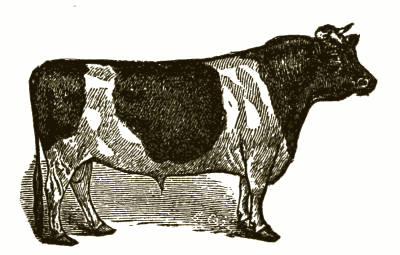
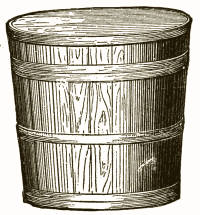
WHITE ASH BUTTER TUB
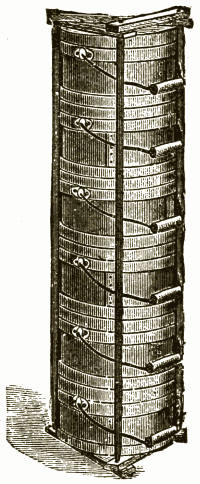
NINE POUND BALE BOXES.
The size, shape and style of package for butter makers to use, must depend largely upon the demands of the market to which the butter is shipped. A few years ago large quantities of roll butter were marketed in Chicago during the colder months; now you may travel from one end of the market to the other and not see a hundred rolls. It is but a short time ago that earthen crocks and jars were extensively used; now you scarcely ever see them. The cause for this is, that earthen vessels, of any kind, are not only liable to break, but are also more difficult to handle in large quantities, and weigh much more than wooden packages. The great bulk of butter that comes to Chicago now, is packed[Pg 47] in white ash tubs and bale boxes. Occasionally we see a tin package with wood veneer, but they have never come into general use for the reason that the acid gets under the tin and causes rust. Wooden packages are just now most popular, and as the manufacturers have reduced the cost of manufacturing them to a point where earthenware and tin cannot compete in price, we may look to see them in use for years to come. The ordinary white ash tubs can be had of every dairy supply dealer and nearly all of the general stores; they may be had in 20 lb., 25 lb., 30 lb., 40 lb. and 60 lb. sizes. An illustration of the nine-pound bale boxes in crate is also given. During the last two years these bale boxes have become very popular. They can be shipped in crates of six and are convenient to handle; they can be had for about twelve cents apiece.
In packing butter in wooden vessels we must guard against "woody taste," and there is but one way to do this, that is, to soak the packages from 24 to 48 hours in strong brine and then thoroughly scald them out. Even this method sometimes fails to accomplish the work. A capital way to prevent woody taste, is to line the package with parchment paper, which not only prevents the butter from taking on a woody flavor, but also prevents soakage and excludes the air. This parchment paper may now be had of all dairy implement dealers, in sheets and circles of any size. It costs about thirty cents a pound, and a pound is sufficient to pack several hundred pounds of butter.
There is still quite a trade in print butter, and when nicely packed in one or two-pound prints and of good quality it sells quickly, on account of its convenient shape for family use. For print butter there has been invented a machine which stamps out one-half and one-pound blocks very quickly and quite artistically. When butter is shipped in this form it should be first carefully wrapped in cloth or parchment paper and packed in boxes in crates. Each box should contain but one block of butter, as piling one block upon another would be likely to press out the delicate[Pg 49] figures moulded or stamped on the block. The blocks for these patent printing machines are sometimes artistically carved, so that the blocks of butter show sheaves of wheat, acorns, etc., and sometimes with the maker's initials or monogram. For home use the old fashioned round mould holding from a quarter of a pound to two pounds is still extensively used, and when properly soaked in cold water before moulding, makes a very nice print of butter. These patent printers and moulds save much time and are a great convenience over the old way of forming the butter into rolls.
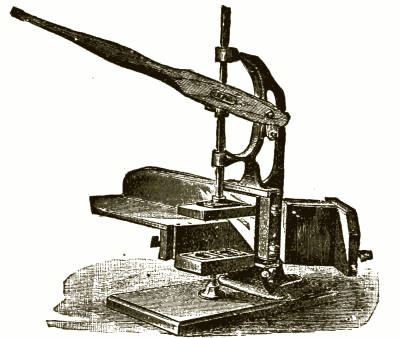
I X L BUTTER PRINTER.
In packing it is always better to pack each churning in a separate tub or box, as the tub that contains different churnings will not be of uniform solidity or color throughout, and will therefore not sell for as much as a tub perfectly uniform.
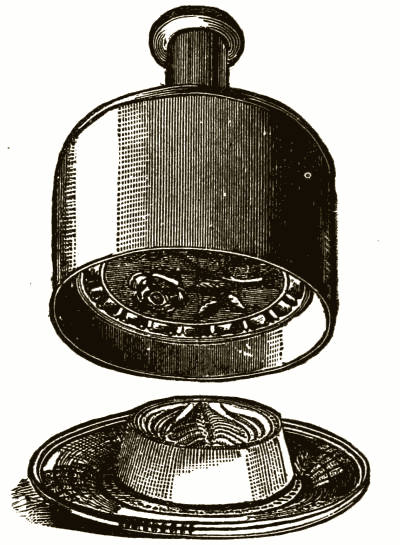
ONE POUND BUTTER MOULD.
Remember to soak the covers of the packages, and before fastening them on sprinkle salt to a depth of a quarter of an inch over[Pg 51] the top of the butter cloth or paper. Never leave the cover off the packages for any length of time, for the reason that it will not only cause the top of the butter to become discolored, but it will also admit the air and spoil the top of the butter for several inches.
The moment you have packed your butter get it into a cool place—the cooler the better—and thereafter keep it as cool as possible, until you have disposed of it.


Frederic Sumner says "There is no more use in trying to run a dairy without a good tested thermometer than there would be to attempt sailing a vessel without a rudder," and I heartily agree with him. A good thermometer can be purchased for from fifty cents to a dollar, and at these prices is certainly within the reach of every dairyman. Too much depends upon the temperature of the water in which we cool our milk, the room we ripen our cream in, do our churning in, and the temperature of the milk, cream, and the butter itself, to attempt any guess work. Our grandmothers used thumb and finger to ascertain the temperature of milk and cream, but in these days of fifty cents, seventy-five cents, and a dollar a pound butter we find "thumb-rule" will not work. An illustration[Pg 53] of a thermometer made expressly for dairy use, is given; they are made of glass and float upright in the milk or cream. The churning and cheese points are marked for the convenience of new beginners; they retail at about fifty cents, and can be purchased from any dealer in dairy goods.

For A B C Butter Makers.
Test your cows.
Never fill the churn over half full.
Never touch the butter with your hands.
Cream rises best in a falling temperature.
Never churn fresh unripened cream with ripened cream.
After cream becomes sour, the more ripening the more it depreciates.
The best time for churning is just before the acidity becomes apparent.
Never let your butter get warm; when once warmed through it will lose its flavor.
Excessive working makes crumbly butter, spoils the grain and injures the flavor.
Never mix night's with morning's milk, as the warmth of the new and the coldness of the old, hastens change and decomposition.
All kinds of disagreeable odors are easily absorbed by salt. Keep it, therefore, in a clean, dry place, in linen sacks, if it is to be used for butter making.
The best butter has the least competition to contend against, while the worst dairy products[Pg 55] have the most. The better anything is, the more rare is it and the greater its value.
A butter maker that uses his fingers instead of a thermometer, to find out the temperature of milk or cream will never make a success.
Cleanliness should be the Alpha and Omega of butter making. Absolute cleanliness as regards person, stable, utensils and package.
Faults—The quickest way to find out the faulty points in your butter, is to send a sample of it to some reliable butter buyer and ask him to score it.
The difference between the dairyman who makes $50.00 a year, per cow, and one who makes $30.00, is that the first works intelligently, the second mechanically.
Details—The price of success in butter making, as in all other classes of business, is strict attention to the little details; it's the sum of all these little things that determines whether your butter is to be sold for ten cents a pound or as a high priced luxury.
The disadvantages of the system of setting milk in shallow pans or crocks, for raising cream, are that a long period elapses before the skimming is completed, too much space is required, and in Summer the milk becomes sour before the whole of the cream is raised.
Labor saving appliances are intended, as the name implies, to save labor, but they do not render care, thought and diligence the less necessary. To understand the principles that underlie the business of butter making, is as imperative as to use the most improved utensils.
By keeping a strict account only, can you find out the extent of your success or failure. If the balance is on the right side, you will know whether and how much it can be increased; if it is on the wrong side, you will be more strongly convinced of the necessity for improvement.
If you keep your cows in a healthy condition, milk regularly; set the milk in air tight cans with good cold water (either ice or spring); skim every twenty-four hours; ripen the cream properly; churn in a barrel churn or some other good churn on the same principle; wash the butter well while still in the churn in granular state; you will never be troubled with white specks in your butter.
—BY N. BIGALOW, STOWE, VERMONT.—
It is necessary to have good cows to start with, and if good butter is the object sought I prefer good Jerseys. The next thing is good feed. Grass that is fresh and tender is best of all. This does not last very long up here in Vermont. My cows have a feed of green corn fodder, at night, and a small feed of grain, in the morning. I prefer to mix different kinds of grain together. It must be all sound and good. Make the cows comfortable and contented. Kind treatment is indispensable, and the more regularity in caring for them the better.
We try to keep the milk entirely clean. If it is necessary we wash the cows' bags, before milking. The milk is strained into large, open pans, and as soon as the animal heat is out of it, the pans are covered over with thin cotton cloth. The covers are made by sewing the edges of the cloth to some strips of basswood, about three-fourths of an inch square[Pg 58] and a little longer than the pans. They cost but a trifle, and after using them ten years we would hardly make butter without them. The butter is not quite so yellow, at first, for raising the cream under the covers, but will be after it has stood a few hours.
When we first tried our large pans, we used to run water around them, but the coolers have got to leaking, and we do not think it would pay to get new ones.
Our rule is to skim the milk soon after it sours, as the cream will come off easily. We keep the cream in a cellar, when it is necessary, but prefer to keep it in the milk room, when it is not too warm. Our dairy is small, and we have churned only twice a week, this year. We use the Stoddard churn, and would not use a float churn. I have never seen the acme churn yet, and hardly think it has been made. 58 degrees is the right temperature at which to churn the cream, in warm weather: 62 in cold, and 60 in spring and fall. We put in from three to six quarts of water to thin the cream, and if the cream is too warm we use cold water (we have a cold spring), and in extreme warm weather use a little ice. If the cream is too cold we warm the water sometimes up to 120 degrees. If that will not answer, the cream[Pg 59] must be warmed beforehand. The buttermilk is drawn off as soon as it can be done, and leave most of the butter in the churn. Any butter that runs out is put back with a skimmer. We use cold water enough to keep the butter in the grain, and wash it until the water runs clear. I suppose brine would be better, but have not used it much. After the butter has drained, the salt is strained in with a paddle; and then it is taken out with the paddle and pressed into the butter bowl. We use about an ounce of salt to a pound, but some of it works out. After it has stood a few hours, it is worked with a lever in an old fashioned butter worker, just enough to get the salt in evenly, and then it is ready to print. We always try to injure the grain as little as possible.
Our printer holds four pounds, and makes eight half pound prints. The prints are put up in four pound boxes, and cut apart with wooden blades. The boxes are made here in Stowe, and are washed and scalded with boiling water, sprinkled with salt.
Our milk house is shaded on the eastern side by a willow tree, and on the southern by another building, and we can cool it to some extent with currents of air. But if we should admit currents of air, without the covers over[Pg 60] the pans, there would be white specks in the butter.
We use butter color when it is necessary to color the butter, but think it better to color it too little than too much.
I am in the habit of mixing a small quantity of cotton seed meal with the grain for the cows, and think I get a little more milk from that than anything else. Linseed meal is very high here, and I have never used it.
Last, but not least, the cows must have pure air to breathe, and the milk, cream and butter must be kept in a good atmosphere.
I am fully convinced that any farmer that makes a prime article of butter, of uniform quality, has an excellent opportunity to use common sense and sound judgment.
Consumers of such butter, as I have described, need not have any fear that they are eating anything that is, or ever was, filthy or unwholesome.
THE DAIRYMAN'S LIBRARY.
| Creaming Milk by Centrifugal Force | $ | 50 | ||||
| Hazard's Butter and Butter Making | 25 | |||||
| Curtis' Hints on Dairying | 50 | |||||
| Willard's Practical Dairy Husbandry | 3 | 00 | ||||
| Willard's Practical Butter Book | 1 | 25 | ||||
| ABC Butter Making, by Burch | 30 | |||||
| Harris' Cheese and Butter Maker's Hand Book | 1 | 50 | ||||
| The Jersey, Alderney and Guernsey Cow | 1 | 75 | ||||
| Feeding Animals. Stewart | 2 | 00 | ||||
| Dadd's American Cattle Doctor | 1 | 75 | ||||
| Guenon's Treatise on Milch Cows | 1 | 25 | ||||
| Quincy on Soiling of Cattle | 1 | 50 | ||||
| Keeping One Cow | 1 | 25 | ||||
| Jennings' Cattle and their Diseases | 2 | 00 | ||||
| Barn Plans and Out Buildings | 1 | 75 |
Any one of the above books will be sent post-paid on receipt of price.
The Dairy World, Chicago, Ill.
THE
Dairy World
A MONTHLY JOURNAL FOR THE
Creamery, Cheese Factory
AND
PRIVATE DAIRY.
Finely Printed, Elegantly Illustrated and ably Edited by Practical American, Swedish and Danish Butter and Cheese Makers.
$1.00 PER ANNUM,
Sample Copies 10 Cents.
The Dairy World,
CHICAGO, ILL.
WOOL GROWERS!
READ THE
AMERICAN
Sheep Breeder.
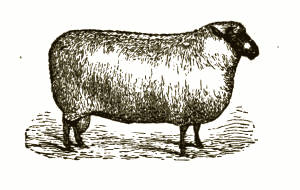
An ably edited, elegantly illustrated monthly magazine, published in the interests of sheep-breeders and wool-growers everywhere.
ONLY $1.00 PER ANNUM.
Address,
C. S. BURCH PUBLISHING CO.,
CHICAGO, ILL.
TRANSCRIBER'S NOTES
—Obvious print and punctuation errors fixed.
—Illustrations have been repositioned so as not to split paragraphs.
—Cover image has been produced by transcriber and placed in public domain.